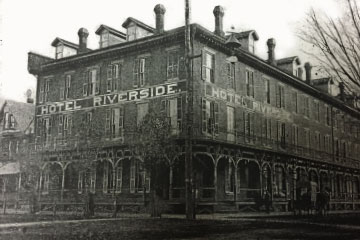In the Early 1800’s
In 1834, Jerry Church, Lock Haven’s founder, sold the town’s first lot: the parcel of ground on which Lindsey Place now sits. An early frame hotel was constructed on the site, but in December 1862, a devastating fire destroyed it and nearly every building in the adjoining two-block area, leaving many of the nearby lots available for new development.
The following year, F. Proctor Myers announced plans to build a new and more elegant hotel on this site. The “Washington House” opened for guests in August 1864. It was constructed of red brick at a cost of $32,000. After prospering for six years, the hotel suffered another fire but this time damage was limited to the roof. With the 1869 construction of the Clinton County Courthouse directly across the street, the location had gained in prominence and within a year of the second fire, plans were announced to enlarge and refurbish the hotel. In June 1871, the hotel, enlarged to its present day dimensions, reopened under the name “Montour House.”
During the later 1800s, Lock Haven was growing rapidly due to the lumber industry, the extension of the railroad, and the development of commerce. Educational opportunities expanded with the establishment of the Central State Normal School, now Lock Haven University. The “Montour House” served as the Central State Normal School for 15 months following an 1888 fire, which destroyed all of the school’s buildings.
HOTEL RIVERSIDE, CIRCA 1892
In December 1890, Peter Meitzler purchased the “Montour House” and completely refurbished the building, creating a grand, Victorian-style structure. He added elaborate porches and balconies and renamed his building “Hotel Meitzler,” which opened in September 1891 in lavish style. The rooms and halls were carpeted with “the most beautiful and luxurious brussels,” electric speaking tubes were placed in every room, and “Edison incandescent” lighting replaced the old gas fixtures. The newspaper account of the opening noted that this was the only hotel in the country with such provisions.
Because of the hotel’s new balconies and a newly constructed wharf along the riverbank, Meitzler promptly changed the hotel’s name to “Hotel Riverside.” After 18 years of successfully operating the hotel, Peter Meitzler died in April 1909.
Newspaper Picture
From the early 1900’s
With extensive improvements completed in 1910, the building’s new owners renamed the hotel the “New Com- mercial Hotel.” Further renovations in 1919 altered the roof shape to its present style and adapted the hotel for use as an apartment building. It was renamed “Riverside Apartments,” a name it would carry until 1931, when it was again renamed “Riverview Apartments.”
… to present day Lindsey Place
In 1986, Abby and Ron Pete purchased the hotel, circumventing an effort by the county to demolish it and construct a parking lot. By this time, the hotel was in an extreme state of disrepair. Ron Pete began restoring and redesigning the building, apartment by apartment on the second and third floors. By the time he reached the first floor, he realized he needed to make the building more equitable and tested the feasibility of providing luxury suites. At first, three suites were completed. As the suites proved to be a viable option, Ron slowly added four more until there were seven. To complete the newly improved
building, it was painted to portray a row of five, 3-story townhomes and renamed “Lindsey Place,” after Abby and Ron’s youngest daughter. The renovation of the courtyard in 1999 added the finishing touch to the project.
“Lindsey Place,” is located in the Water Street Historic District and is listed in the National Register of Historic Places. We hope you enjoy your stay in this Lock Haven landmark.

